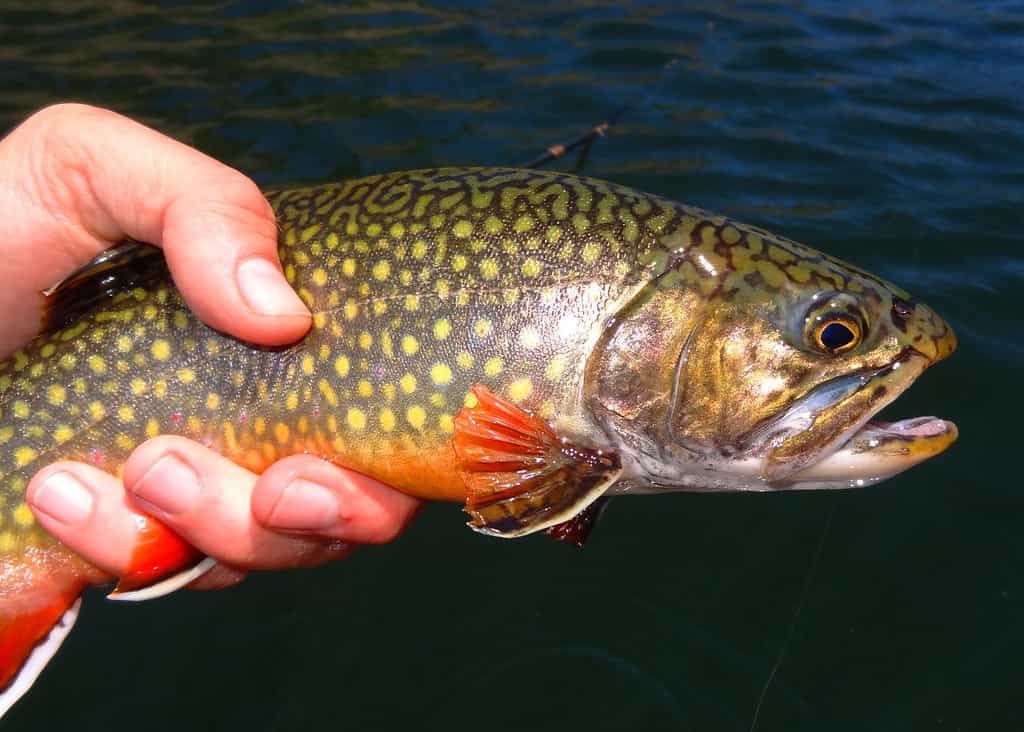The brook trout is the state fish for several states, including Michigan, New Hampshire, New Jersey, New York, North Carolina, Pennsylvania, Vermont, Virginia, and West Virginia. This freshwater fish is a delicious eating fish, and many fishermen attempt to catch them in common bodies of water like streams, ponds, and lakes.
This highly sought-after fish makes for great fishing, and some can grow to massive sizes and weights. This article will reveal the largest brook trout ever caught, as well as some fishing tips for success with this gorgeous freshwater creature.
What Is a Brook Trout?
Brook trout, also called speckled trout, are a colorful freshwater fish found in Eastern North America, including Canada and the northern portions of the United States. Despite its name, the brook trout is actually part of the salmon family (Salmonidae). This popular fish has an olive-green back with yellow spots, which is called vermiculation. Its sides and belly are orange and red, its body is wide in the middle, and it has a large mouth and rounded snout.

A high brook trout population is an indication of clean/good-quality water.
©Matt Jeppson/Shutterstock.com
Depending on their environment, brook trout tend to grow at different rates and adopt different behavioral patterns. For instance, large lake brook trout occupy — you guessed it — larger lakes in the northern U.S. and Canada and tend to grow larger than brook trout in other locations. On the other hand, small generalist brook trout live in small lakes, ponds, streams, and rivers, remaining much smaller and having a shorter lifespan than other brook trout.
What Is the Largest Brook Trout Ever Caught?
The largest brook trout ever caught weighed 14.5 pounds and measured 31.5 inches long and 23 inches in girth. This monster was caught by Dr. W. J. Cook on July 21, 1915, in the Rabbit Rapids of the Nipigon River in Northern Ontario. However, Cook didn’t weigh the fish as soon as he caught it, meaning it had time to decompose before it reached a scale. As a result, many believe it actually weighed over 20 pounds initially. However, we’ll never truly know its actual weight, so the record remains 14.5 pounds.
Depending on its habitat, a full-grown brook trout can grow between 10 to 25 inches in size and weigh between 0.6 to 6.6 pounds. However, most brook trout are smaller, while the record largest was much bigger. Keep in mind that the record-breaker was the largest ever caught; imagine how many large brook trout roam free without ever being recorded!
Brook Trout Habitat
As stated earlier, brook trout reside in the eastern regions of northern U.S. and Canada. Brook trout are freshwater fish most commonly found in streams, rivers, lakes, and ponds. However, some brook trout (known as sea-run or salters) will migrate to saltwater along the Atlantic coast for food. In fact, this fish is a migratory species that moves to different locations to establish a more sustainable habitat during certain seasons.

The brook trout is a popular fish in the U.S., with nine states naming it the state fish.
©M Rose/Shutterstock.com
Specifically, brook trout do best in water temperatures between 55 and 60 degrees Fahrenheit. Water temperatures approaching or exceeding 75 Fahrenheit degrees can quickly become lethal to the brook trout. These fish love to spend time near gravel, sandy bottoms, or vegetation in their freshwater ecosystems.
Brook Trout Fishing: Tips and Tricks for the Best Catch
Brook trout is a popular fish in the fishing world. These fish are most active during dawn and dusk. As a result, many will wake early or stay out past dark to secure the best catch. As mentioned earlier, the size of brook trout will depend on its environment, with bigger fish often inhabiting large lakes.
A-Z Animals spoke with Eric Guarino of Uncle Larry Outdoors, “a community designed to promote collaboration and engagement between everyday outdoorsmen,” to get the best tips for brook trout fishing.
“Fish tributaries off main rivers (and then the creeks of those tributaries), [as] big brook trout can come out of small water,” he said. “Throw the lightest line possible and the smallest jigs you have, [or go] fly fishing if you know how.”
He also recommended moving and casting quietly. You want to avoid casting shadows or making loud splashes that might scare fish away.
When in doubt, “Go where others won’t, hike farther than others will, [and] wade longer than others can,” Guarino said. “Believe; fish with confidence.”
Ready to break the 1915 record?
The photo featured at the top of this post is © Slowmotion GLI/Shutterstock.com
Thank you for reading! Have some feedback for us? Contact the AZ Animals editorial team.






